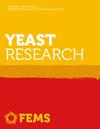Yeast sexes: mating types do not determine the sexes in Metschnikowia species.
IF 2.4
4区 生物学
Q3 BIOTECHNOLOGY & APPLIED MICROBIOLOGY
引用次数: 0
Abstract
Although filamentous Ascomycetes may produce structures that are interpreted as male and female gametangia, ascomycetous yeasts are generally not considered to possess male and female sexes. In haplontic yeasts of the genus Metschnikowia, the sexual cycle begins with the fusion of two morphologically identical cells of complementary mating types. Soon after conjugation, a protuberance emerges from one of the conjugants, eventually maturing into an ascus. The originating cell can be regarded as an ascus mother cell, hence as female. We tested the hypothesis that the sexes, female or male, are determined by the mating types. There were good reasons to hypothesize further that mating type α cells are male. In a conceptually simple experiment, we observed the early stages of the mating reaction of mating types differentially labeled with fluorescent concanavalin A conjugates. Three large-spored Metschnikowia species, M. amazonensis, M. continentalis, and M. matae, were examined. In all three, the sexes were found to be independent of mating type, cautioning that the two terms should not be used interchangeably.酵母的性别:交配类型并不能决定 Metschnikowia 物种的性别。
尽管丝状子囊菌可能产生被解释为雌雄配子器的结构,但一般认为子囊酵母菌不具有雌雄性别。在梅茨尼科维亚属(Metschnikowia)的单倍体酵母菌中,性周期始于两个形态相同的互补交配型细胞的融合。结合后不久,从其中一个结合体中出现一个突起,最终成熟为腹腔。起源细胞可被视为腹水母细胞,因此是雌性的。我们测试了由交配类型决定性别(雌性或雄性)的假设。我们有充分的理由进一步假设交配型α细胞是雄性的。在一个概念简单的实验中,我们观察了不同交配类型的交配反应的早期阶段,这些交配类型的交配反应是用荧光凝集素A共轭物标记的。我们考察了三个大孢子 Metschnikowia 物种:M. amazonensis、M. continentalis 和 M. matae。在所有这三个物种中,性别都与交配类型无关,因此这两个术语不能互换使用。
本文章由计算机程序翻译,如有差异,请以英文原文为准。
求助全文
约1分钟内获得全文
求助全文
来源期刊

FEMS yeast research
生物-生物工程与应用微生物
CiteScore
5.70
自引率
6.20%
发文量
54
审稿时长
1 months
期刊介绍:
FEMS Yeast Research offers efficient publication of high-quality original Research Articles, Mini-reviews, Letters to the Editor, Perspectives and Commentaries that express current opinions. The journal will select for publication only those manuscripts deemed to be of major relevance to the field and generally will not consider articles that are largely descriptive without insights on underlying mechanism or biology. Submissions on any yeast species are welcome provided they report results within the scope outlined below and are of significance to the yeast field.
 求助内容:
求助内容: 应助结果提醒方式:
应助结果提醒方式:


